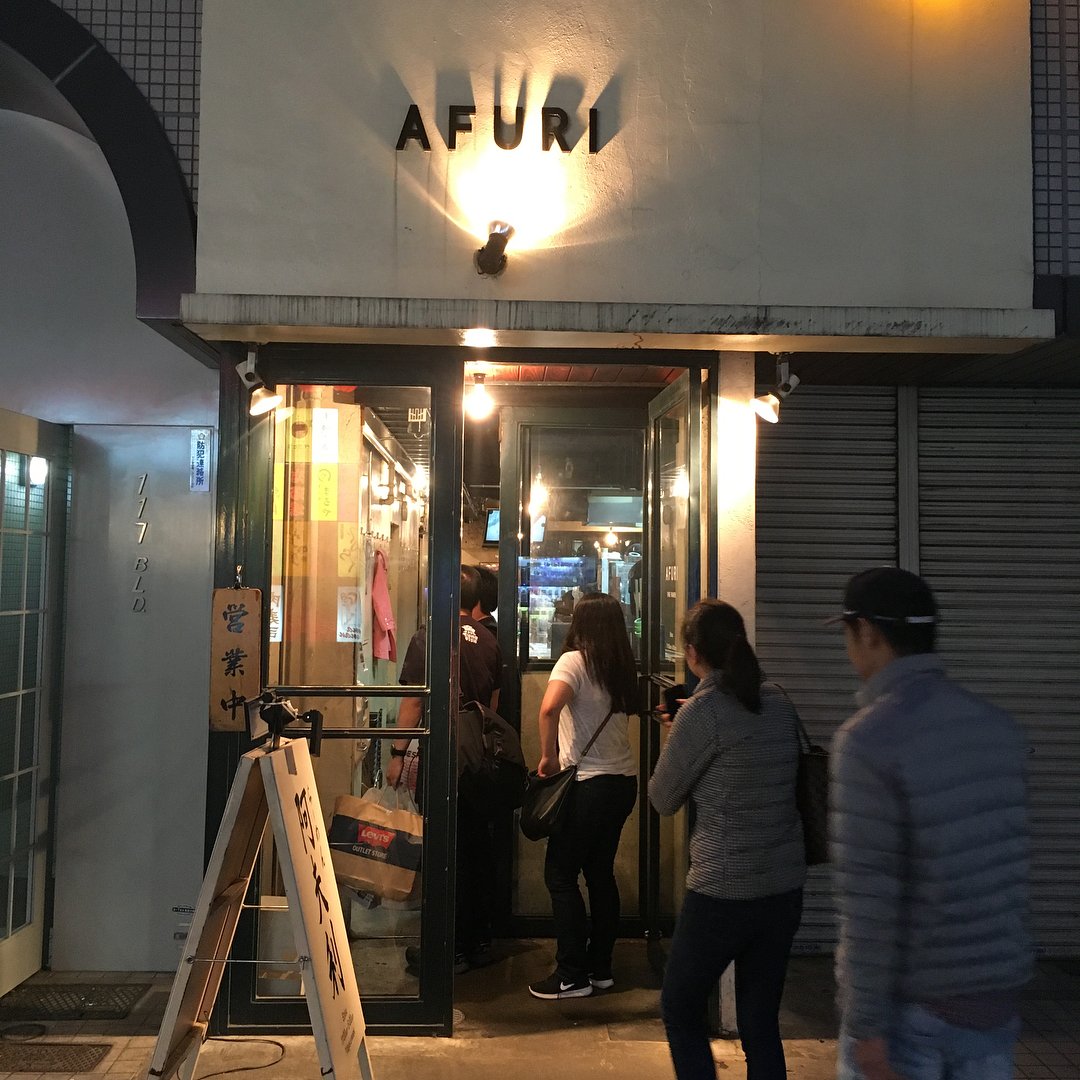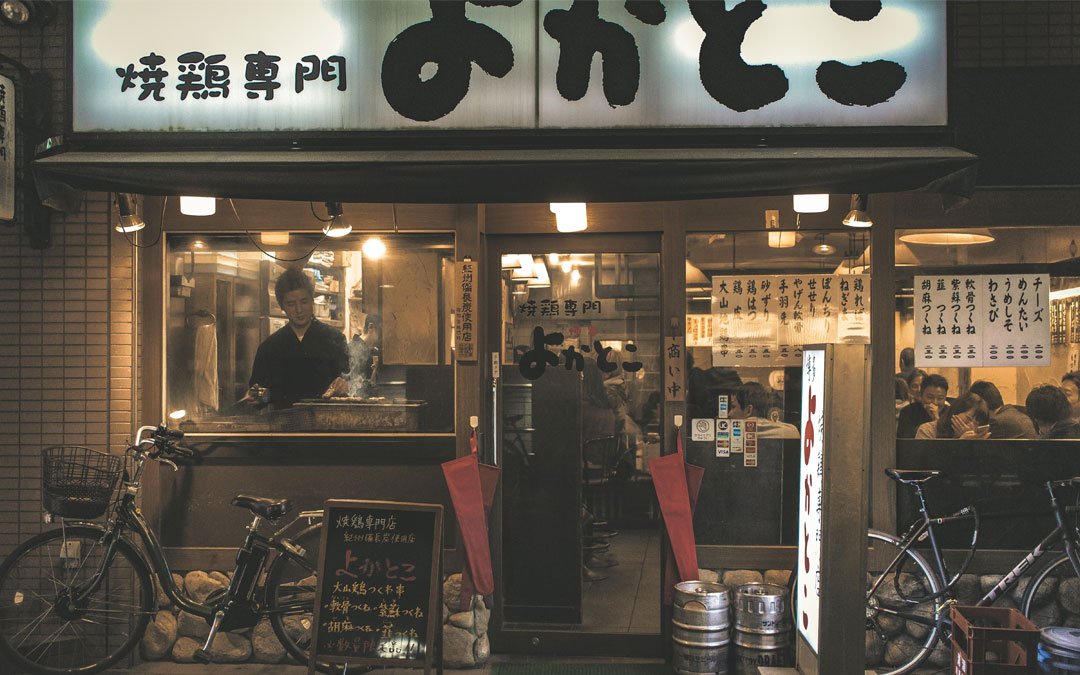Can you get a good meal after 22:00 in Tokyo? Absolutely. Approach any business-attired men and women, and they would gladly point you to the nearest ramen stall. And for the jet lagged who fancy a drink at 3am, head over to Shinjuku Golden Gai and find yourself making new friends in one of the tiniest bars along the neon-lit alley.
And considering what is on almost every corner of the street – the ubiquitous vending machines and 24hrs convenience marts which offer a wide array of food – you’ll find no problems scoring a 3-course meal for ¥2000 or less.
Japanese convenience marts may be the stuff of legend (Lawson’s egg salad sandwich is recommended by no less than Anthony Bourdain himself), but bento, instant noodles and sweet pancakes can only get you so far before you start wondering where the locals go to satisfy their late-night hunger pangs. Try these recommendations.
1.JOMON ROPPONGI
Because no trip to Japan would be complete without smelling like the rich, charcoal-edged fumes of proper yakitori, we recommend dropping by Jomon Roppongi for their momo negima. The alternating pieces of juicy chicken thigh meat and Japanese leeks – grilled and basted with the cooking style’s signature savoury-sweet sauce – will leave you wanting more.
But the world-famous, crowd-pleasing dish nearly wasn’t to be. In Edo Tokyo (1603-1868), Buddhist influence saw the populace rejecting burning meat as a cooking method, regarding the smell distasteful.

Instead, poultry would be cooked nimono style – simmered in broth – a preparation style still popular today.
Thankfully, the Meji Era (1868 to 1912) saw the revival of sweet and salty tare, preserving the yakitori we know and love today.
Yakitori can be enjoyed at any time of the year. It is known for being the salaryman snack as there is always a yakitori-ya (grilled chicken skewer shop) near train stations for the tired men in suits to enjoy an after-work snack with beer.
So what sets Jomon apart from the other smaller yakitori joints that dot the streets of Tokyo?
Located away from the bustling main street of Roppongi, it’s easy to miss this local gem. There is no signage to catch the eye, and the stack of crates piled against the shop front doesn’t help either. But don’t be quick to dismiss Jomon based on its exterior. Instead, let your nose take over – the rich aroma of charred meat that waft off the grills has tempted countless passers-by, and you’ll find yourself joining the queue.
Despite its lack of décor, the cosy ambiance and congeniality of Jomon staff more than make up for it, explaining their popularity with the locals. Take the bar seat for an authentic yakitori experience: watch as the experts grill skewers of meat in front of you on an open fire until crispy on the outside, juicy and tender on the inside. There is also a wide variety of fruit wines and sake to pair with the grilled dishes which the staff will gladly recommend.
And here’s a tip from the locals: The authentic yakitori-ya grills their skewers over Japanese white charcoal called binchotan. If you find a yakitori-ya grilling over gas, move on to the next stall.
Address
5-9-17 Roppongi | Fujimori Bldg. 1F, Roppongi, Minato 106-0032, Tokyo Prefecture
Opening Hours
Mon to Fri: 5:30 PM – 11:30 PM
Sat to Sun: 5:30 PM – 5:00 AM
[su_gmap width=”400″ height=”320″ address=”5-9-17 Roppongi | Fujimori Bldg. 1F, Roppongi, Minato 106-0032, Tokyo Prefecture” title=”Jomon Roppongi”]
2. AFURI RAMEN
Ramen is the quintessential fast food of Japan and a culinary hit worldwide. You can find countless high-quality ramen shops offering their own take on the broth-and-noodle combination in Tokyo. Like many others, your first ramen encounter probably took place in the hallowed, history-drenched halls of long-standing franchises such as Ichiran or Ippudo, with the chains’ thick, rich and creamy tonkotsu (pork bone) broth serving as your initiation. But to be a true ramen devotee, you need to pay Afuri Ramen a visit.
Afuri’s signature yuzu-shio ramen has a light and refreshing broth made from chicken, seaweed and seafood with a hint of yuzu. Each steaming bowl of edible art comes with a seasoned soft-boiled egg, bamboo shoots and a slice of melt-in-your-mouth grilled pork.
A clue to the popularity of Afuri Ramen may be discerned in the eatery’s name and logo. Fresh spring water from Mt. Afuri in Kanagawa Prefecture features as an exclusive ingredient in both the broth and noodles, which are made in a central kitchen at the foot of Mt. Afuri.

The original Afuri Ramen outlet, debuted in 2003, is a few minutes walk from Ebisu station. Tucked on a side street of the trendy Ebisu neighbourhood, the eatery features a minimalist, chic industrial exterior.
Ramen restaurants in Japan are designed to be utilitarian – Afuri can accommodate 15 to 20 diners, and one is expected not to hoard the seat after a meal. Upon entering, our presence was fervently acknowledged by young chefs donned in black shirts moving like clockwork in the open kitchen to assemble the perfect bowl of ramen.
Like most ramen eateries in Tokyo, the ordering is done via an automated machine which can be nerve-racking, especially if you have people waiting in line behind. But fear not, the menu is also available in English. Each bowl of ramen in golden broth can be customised with different toppings and types of noodles. Add that extra slice of chargrilled pork, don’t hesitate. But take your time to savour it – each glistening slice bobbing in your bowl of Afuri ramen is freshly grilled over an open fire upon order.
In the mecca of ramen, Afuri is refreshingly unique, well worth the wait and the extra calories.
Address
1-1-7 Ebisu | 117 Bldg.1F, Ebisu, Shibuya 150-0013, Tokyo Prefecture
Opening Hours
Daily from 11:00am – 5:00am
[su_gmap width=”400″ height=”320″ address=”1-1-7 Ebisu | 117 Bldg.1F, Ebisu, Shibuya 150-0013, Tokyo Prefecture” title=”Afuri Ramen”]
3. TAKIZEN
Oden is a Japanese one-pot wonder – which seems deceptively simple – made using several ingredients like fishcakes, konjac, hard-boiled eggs, and white radish simmered in dashi, a savoury stock made from seaweed and dried bonito flakes. The key to a good pot of oden is the quality of dashi that brings out the umami taste.
Traditionally, oden is a warming winter stew and usually savoured with warm sake. When trays of oden can be seen in convenience stores, you’ll know winter has arrived.
Is there a place to enjoy oden all year round in Tokyo? Enter Ginza Corridor – a street that runs under the rail tracks which link Yurakucho Station and Shimbashi Station. Here is where you can find just about anything on this street, from chain gyoza restaurants to specialist Japanese wine and whiskey bars.
Look for an inconspicuous bar along the Ginza Corridor – spotting a black wooden door and an outdoor display stand. You’d think that this is yet another drinking spot – but you’d be only half correct.

Inside, you’ll find the soothingly lit Takizen, where conversations and laughter dominate the smokeless atmosphere, and the smell of dashi lingers in the air. Follow your senses and you’ll soon spot the the simmering centrepiece at the bar – a large open metal pan of oden. Or, as Takizen fondly described on its menu, the soul food of Japan.
Sidle up to the open pan and pick and choose from different vegetables, tofu and fried fish paste – simply point and smile at the bartender. If you’re overwhelmed by what to order, a slice of daikon and konjac served with mustard on the side makes for a delicious and piping-hot introduction. The humble daikon, bursting with umami after simmering in dashi for hours, takes centerstage here, customary to its position as the one key ingredient no oden can go without. Meanwhile, konjac a gelatinous cake made from elephant yam retains its characteristic flavourlessness, but becomes oddly delectable when consumed with dashi.
To fully appreciate oden – its contrasting flavours and textures – it is best matched with sake. Check with the staff of Takizen for recommendations.
Be sure to try at least one of the tofu products like fukuro (fried tofu pouches stuffed with mushrooms and noodles), ganmo (fried tofu patties with vegetable bits) or atsu-age (fried tofu pieces) – doesn’t it all sound delicious?
Load up your bowl, take a seat at the bar counter, and watch the bartender and patrons keeping the place bumping through the night.
Address
7-108 Ginza, Chuo 104-0061, Tokyo Prefecture
Opening Hours
5:00pm – 3:00am Daily (5:00am on Fridays)
[su_gmap width=”400″ height=”320″ address=”7-108 Ginza, Chuo 104-0061, Tokyo Prefecture” title=”Takizen”]


